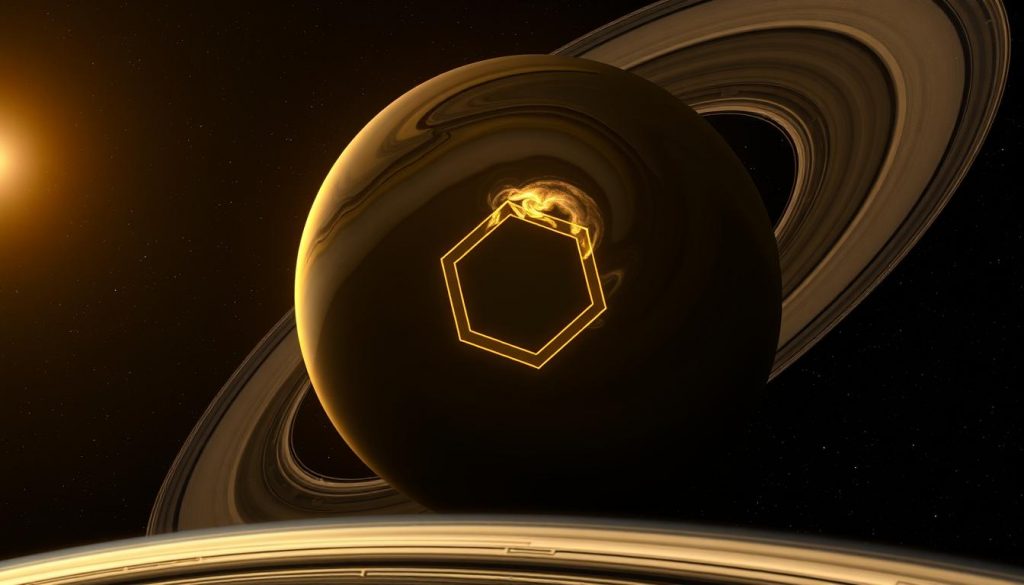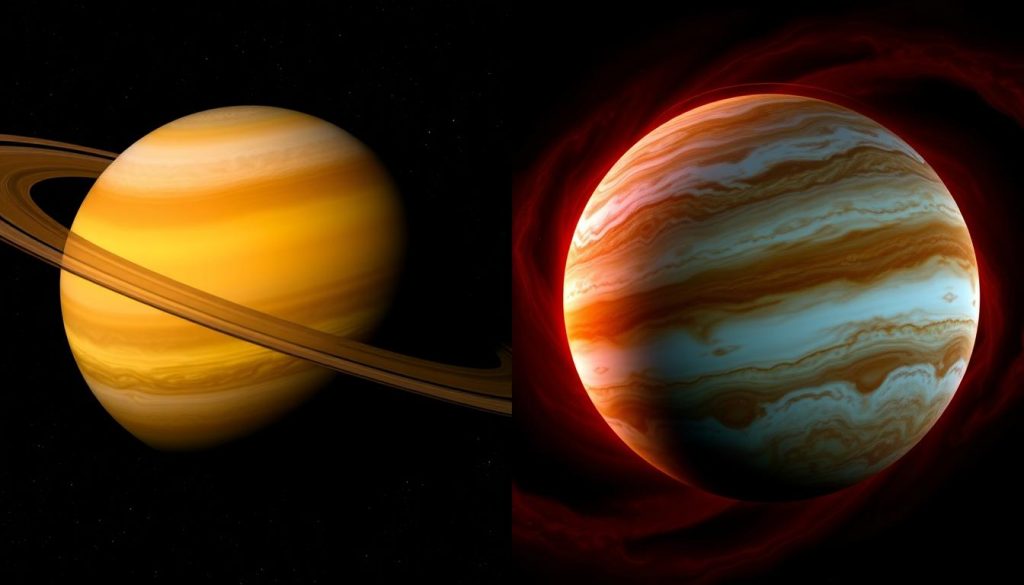The mystery of Saturn’s hexagon: unique formations on other planets.
Saturn’s hexagon is a fascinating phenomenon that has caught the attention of many. It’s a hexagonal jet stream at Saturn’s north pole, first seen by NASA’s Voyager in the 1980s. The Cassini mission from 2004 to 2017 showed its stability and unique shape, unlike Earth’s weather.
Anúncios
This hexagon is huge, with a diameter of about 20,000 miles. Its air moves at 200 mph. It’s a mystery to scientists who study the atmosphere of planets.
This formation is more than just interesting. It makes us wonder how long it lasts and how it was made. We’ll look at its features and how it compares to other hexagonal patterns in nature and space. Join us as we uncover the secrets of Saturn’s hexagon and its unique weather.
Key Takeaways
- Saturn’s hexagon has been observed for over 38 years, starting with NASA’s Voyager missions.
- The hexagon measures about 20,000 miles in diameter and features air moving at speeds of 200 mph.
- Research conducted by the Cassini mission revealed insights into the hexagon’s structure and atmospheric dynamics.
- The hexagonal formation extends around 180 miles into Saturn’s stratosphere.
- Seasonal cycles on Saturn last approximately 7.5 years due to its long orbital period of 30 Earth years.
Introduction to Saturn’s Hexagon
Saturn’s hexagon is a stunning feature at 78°N latitude. It’s huge, measuring about 29,000 km (18,000 miles) across. Each side is roughly 14,500 km (9,000 miles) long. It’s even bigger than Earth, making it a wonder for scientists.
Since the Voyager spacecraft spotted it in the 1980s, it’s been a topic of interest. It looks like a *northern jet stream*, with fast-moving gases. These gases zip by at over 300 mph, making Saturn’s atmosphere very dynamic.
Anúncios
The hexagon has lasted for over 29.5 Earth years. That’s much longer than Earth’s weather patterns, like hurricanes, which last only a week. This shows how unique Saturn’s hexagon is.
The Cassini spacecraft has helped us learn more about Saturn’s hexagon. It has taken detailed pictures and collected data. This has shown us the hexagon’s five-sided jet stream and its weather patterns.
Changes in the hexagon have been noticed, especially during Saturn’s seasons. These changes started in August 2009. Scientists are still studying these changes, giving us a better view of Saturn’s atmosphere.
In summary, studying Saturn’s hexagon helps us understand the planet better. It shows us the complex weather patterns of Saturn. As technology improves, we’ll learn even more about this fascinating feature.
Historical Discoveries of Saturn’s Hexagon
The Voyager mission in the early 1980s started our journey to understand Saturn’s hexagon. It first spotted this unique six-sided structure at Saturn’s north pole in 1981. Astronomer David A. Godfrey analyzed it in 1988, setting the stage for more research.
NASA’s Cassini mission greatly expanded our knowledge from 2004 to 2017. Over 13 years, scientists collected a lot of data. They found out the hexagon is about 20,000 miles wide, big enough for almost four Earths to fit inside. Winds inside this storm can go up to 300 miles per hour.
Because Saturn’s seasons are long, polar nights can last 15 years. This made it hard to see the hexagon until 2009. Then, sunlight showed its detailed structure. The hexagon is stable, staying the same despite harsh conditions around Saturn.
Studying Saturn’s hexagon has also taught us about atmospheric processes. The flow pattern in the hexagon is similar to how tornadoes and hurricanes form on Earth. The Cassini mission’s findings have greatly helped planetary science. For more on Saturn’s hexagon, check out this detailed article.

Understanding the Structure of Saturn’s Hexagon
Saturn’s hexagon is a fascinating sight into the planet’s atmospheric wonders. It’s unlike anything on Earth and invites us to explore its dimensions and behavior. This unique feature is a key part of Saturn’s atmospheric dynamics.
Dimensions and Composition
The hexagon is huge, spanning about 30,000 kilometers (20,000 miles) across. Early guesses said it went 100 kilometers (60 miles) deep. But new models suggest it could be thousands of kilometers deep, hidden from early spacecraft.
The Voyager spacecraft first spotted it in 1980. Then, NASA’s Cassini spacecraft gave us a closer look starting in 2007. It showed us the hexagon’s details for nearly 40 years. The winds in this storm can hit up to 500 kilometers per hour (300 miles per hour), showing how dynamic Saturn’s atmosphere is.
The Role of Atmospheric Dynamics
To understand Saturn’s hexagon, we must look at its atmospheric forces. The polar vortex at the hexagon’s center is key. It affects the jet streams. Lab tests show how deep heat can create big storms and jet streams.
This shows how Saturn’s weather is different from Earth’s. The hexagon’s cloud pattern is stable yet dynamic. It’s supported by these atmospheric processes that shape its massive structure.
Why Saturn’s Hexagon is Unique
Saturn’s hexagon is unlike any other planetary feature, showing off amazing geometric patterns. It’s found at about 78°N latitude and is huge, with a diameter over twice Earth’s. The jet stream that makes this shape is an incredible 20,000 miles (30,000 kilometers) wide.
The winds inside Saturn’s hexagon are incredibly fast, reaching 300 mph (500 kph). This is much faster than any hurricane on Earth. The hexagon’s size and wind speed offer a unique look into how planets’ atmospheres work.
There’s no hexagon at Saturn’s south pole. Instead, there’s a different kind of vortex. This shows that the conditions for hexagons are special to Saturn’s north pole. Scientists have found that hexagons can form naturally under certain conditions, which explains their presence on Saturn.
Saturn’s long seasons also make its hexagon unique. A year on Saturn is about 29 Earth years, leading to long-lasting seasonal changes. This long cycle helps keep the hexagon stable and visible for a long time.
Comparing Saturn’s hexagon to Earth’s weather systems shows how different it is. Saturn’s jet stream stays in a stable pattern, unlike Earth’s which wanders. This raises interesting questions about Saturn’s atmosphere.
| Feature | Saturn’s Hexagon | Earth’s Largest Hurricane |
|---|---|---|
| Diameter | More than twice that of Earth | Approximately 1,000 miles (1,600 kilometers) |
| Width | Exceeds 29,000 km (18,000 mi) | N/A |
| Wind Speed | Up to 300 mph (500 kph) | Maximum around 215 mph (345 kph) |
| Vortex Size | 50 times larger than typical hurricanes on Earth | Varies |
| Formation Location | North Pole | N/A |
The unique combination of size, wind patterns, and seasons on Saturn creates a one-of-a-kind atmospheric structure. This structure is unlike anything found in other planets’ atmospheres today.
Formation of Hexagonal Patterns in Nature
Hexagonal patterns in nature are both beautiful and functional. They catch the eye of scientists and researchers. By studying how these patterns form, we can learn more about the atmosphere.
Fluid dynamics experiments help us understand these natural formations. They show us how hexagons can form in controlled settings. This gives us a closer look at the processes behind hexagonal shapes.
Laboratory Simulations of Fluid Dynamics
Laboratory experiments with hexagons are key to understanding them. Scientists use rotating fluids in tanks to mimic planetary atmospheres. These experiments show that hexagons form at specific speeds and temperatures.
This mirrors the hexagons on Saturn, showing how important atmosphere conditions are. It’s a big discovery for studying hexagonal patterns.
Similarities with Other Planetary Weather Systems
Comparing weather systems across planets reveals more about hexagons. For example, Jupiter also has hexagonal weather patterns. This helps scientists understand how hexagons form under different conditions.
It shows that gas giants like Saturn and Jupiter might form hexagons in similar ways. But, each planet’s unique environment plays a role in this process.
Saturn’s Hexagon Compared to Other Planetary Formations
Looking at Saturn’s unique atmospheric systems shows interesting differences with other big planets, like Jupiter. We see unique features like Saturn’s south pole vortex and Jupiter’s complex atmosphere. These insights help us understand atmospheric phenomena on different planets.
The Vortex on Saturn’s South Pole
Saturn’s south pole has a big vortex that’s different from the north pole’s hexagon. This vortex is very turbulent and doesn’t have the same structure as the north pole’s hexagon. It creates swirling motions but doesn’t have the hexagonal shapes seen in Saturn’s north pole.
Studies in planetary science show these differences highlight how Saturn and Jupiter’s atmospheres are different.
Comparative Analysis with Jupiter’s Atmosphere
Jupiter’s atmosphere is known for its chaotic storms and intense activity. In contrast, Saturn’s hexagon has stayed the same for over 29.5 Earth years. This shows Saturn’s atmosphere is more stable than Jupiter’s.
Both planets have interesting vortices, but their atmospheres behave in unique ways. Here’s a table that compares some key features:
| Feature | Saturn | Jupiter |
|---|---|---|
| Hexagonal Structure | Present at north pole | Not present |
| Time of Stability | Over 29.5 Earth years | Variable, chaotic storms |
| Wind Speeds | Up to 400 km/h | Varies significantly |
| Polar Vortex | Present, lacks hexagonal geometry | N/A |
| Atmospheric Temperature | -120° C to -180° C | Similar range but more rapidly fluctuating |
These comparisons show Saturn’s hexagonal formations are unique compared to Jupiter’s chaotic weather. Studying these differences helps us understand more about the atmospheres of these planets. It deepens our knowledge of planetary science.

The Mysteries Behind Saturn’s Hexagon
Saturn’s hexagon at the north pole is a fascinating sight. It has puzzled scientists for years, especially how long it lasts. Unlike Earth’s weather, which changes fast, Saturn’s hexagon stays stable for a long time.
This hexagonal shape is huge, with a diameter of about 20,000 miles. Its sides are around 8,600 miles long. Despite the planet’s changing seasons, it remains remarkably steady.
Longevity of the Hexagonal Jet Stream
The winds inside the hexagon are incredibly fast, reaching 200 miles per hour. This makes us wonder what keeps the weather so stable on Saturn. The planet’s seasons change every seven Earth years, affecting the hexagon’s look and behavior.
Data from the Cassini mission shows winds around the hexagon can go over 300 miles per hour. This shows the complex forces at work in this atmospheric wonder.
Current Hypotheses on Formation Mechanisms
Scientists have several theories about how Saturn’s hexagon formed. They think it’s due to fluid dynamics and turbulence in high-pressure areas. Computer simulations have shown that these forces can create hexagonal or even nine-sided shapes.
The most accepted theories point to barotropic instability and vorticity gradients. These explain how the hexagon stays stable for so long.
Conclusion
The study of Saturn’s hexagon is truly captivating. It shows us a six-sided wonder and the complex weather patterns around it. The winds here can reach speeds of 530 kilometers per hour, making it a marvel of nature.
Research into this feature is ongoing. Scientists are trying to understand how it stays in its unique shape. Their work could also help us learn more about other planets’ atmospheres.
The hexagonal shape at Saturn’s north pole is a mystery waiting to be solved. It reminds us of the importance of studying the weather on other planets. By doing so, we can gain a deeper understanding of our own planet and the universe.
